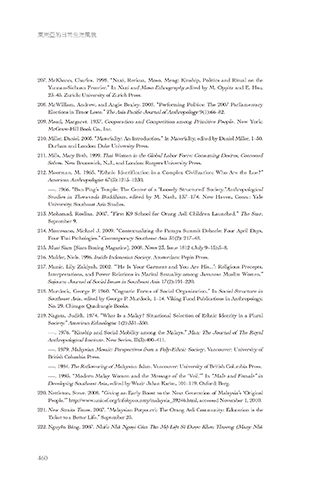Page 462 - 東南亞的日常生活風貌
P. 462
東南亞的日常生活風貌 參考書目與建議閱讀書目
207. McKhann, Charles. 1998. “Naxi, Rerkua, Moso, Meng: Kinship, Politics and Ritual on the Ngoại Cảm Who Have Found Revolutionary Martyr Graves Receive Commendations). July 23.
Yunnan-Sichuan Frontier.” In Naxi and Moso Ethnography,edited by M. Oppitz and E. Hsu, Tifn Phong Online. http://www.tienphong.vn/Tianyon/Index.aspx?ArticleID=90529&Channel
23–45. Zurich: University of Zurich Press. ID=46, accessed November 1, 2010.
208. McWilliam, Andrew, and Angie Bexley. 2008. “Performing Politics: The 2007 Parliamentary 223. Nguyễn Huy Phúc and Trbn Huy Bá. 1979. Ðường Pho Hà Nội (The Streets of Hanoi). Hanoi:
Elections in Timor Leste.” The Asia Pacific Journal of Anthropology 9(1):66–82. Nhà Xuat Bản Hà Nội.
209. Mead, Margaret. 1937. Cooperation and Competition among Primitive People. New York: 224. Nguyen, V. H. 1995 [1944]. The Ancient Civilization of Vietnam. Hanoi: The Gioi Publishers.
McGraw-Hill Book Co., Inc. 225. Nhung Tuyet Tran. 2008. “Gender, Property, and the ‘Autonomy Thesis’ in Southeast Asia:
210. Miller, Daniel. 2005. “Materiality: An Introduction.” In Materiality, edited by Daniel Miller, 1–50. The Endowment of Local Succession in Early Modern Vietnam.” The Journal of Asian Studies
Durham and London: Duke University Press. 67(1):43–72.
211. Mills, Mary Beth. 1999. Thai Women in the Global Labor Force: Consuming Desires, Contested 226. Nicholas, Colin. 2000. The Orang Asli and the Struggle for Resources. Copenhagen: International
Selves. New Brunswick, N.J., and London: Rutgers University Press. Work Group for Indigenous Affairs.
212. Moerman, M. 1965. “Ethnic Identification in a Complex Civilization: Who Are the Lue?” 227. Niessen, S. A. 1985. Motifs of Life in Toba Batak Texts and Textiles. Dordrecht: Foris
American Anthropologist 67(5):1215–1230. Publications.
–. 1966. “Ban Ping’s Temple: The Center of a ‘Loosely Structured’ Society.”Anthropological 228. Ninh Bînh, Cultural Service. 1968. Công Tác Xây Dựng Nep Song Mới, Con Người Mới và Gia
Studies in Theravada Buddhism, edited by M. Nash, 137–174. New Haven, Conn.: Yale Ðînh Tifn Tien Chong Mỹ, Cứu Nước (The Task of Building the New Ways, New Person and
University, Southeast Asia Studies. Progressive Family in the Struggleagainst the Americans to Rescue the Nation). Ninh Bînh: Tỷ
213. Mohamad, Roslina. 2007. “First K9 School for Orang Asli Children Launched.” The Star, Va˘n Hóa Ninh Bînh.
September 9. 229. Noor Aini Syed Amir, Datin. 1991. Malaysian Customs and Etiquette. Singapore and Kuala
214. Montesano, Michael J. 2009. “Contextualizing the Pattaya Summit Debacle: Four April Days, Lumpur: Times Books.
Four Thai Pathologies.” Contemporary Southeast Asia 31(2): 217–48. 230. Nooy-Palm, C. H. M. 1979. The Sa’dan Toraja: A Study of Their Social Life and Religion, Vol. 1.
215. Muai Siam [Siam Boxing Magazine]. 2008. News 23, Issue 1812 (July 9–15):5–8. The Hague: Martinus Nijhoff.
216. Mulder, Niels. 1996. Inside Indonesian Society. Amsterdam: Pepin Press. 231. Oey-Gardiner, Mayling. 1991. “Gender Differences in Schooling in Indonesia.” Bulletin of
217. Munir, Lily Zakiyah. 2002. “‘He Is Your Garment and You Are His...’: Religious Precepts, Indonesian Economic Studies 27(1):57–79.
Interpretations, and Power Relations in Marital Sexuality among Javanese Muslim Women.” 232. Office for Victims of Crime. 2002. “Children as Victims and Witnesses.” In Victims and
Sojourn: Journal of Social Issues in Southeast Asia 17(2):191–220. Victimization, edited by David Shicor and Stephen Tibbetts, 81–102. Prospect Heights, Ill:
218. Murdock, George P. 1960. “Cognatic Forms of Social Organization.” In Social Structure in Waveland Press.
Southeast Asia, edited by George P. Murdock, 1–14. Viking Fund Publications in Anthropology, 233. Olson, Grant. 1991. “Cries over Spilt Holy Water.” Journal of Southeast Asian Studies 22:75–85.
No. 29. Chicago: Quadrangle Books. 234. Ong, Aihwa, and Michael C. Peletz. 1995. Bewitching Women, Pious Men: Gender and Body
219. Nagata, Judith. 1974. “What Is a Malay? Situational Selection of Ethnic Identity in a Plural Politics in Southeast Asia. Berkeley: University of California Press.
Society.” American Ethnologist 1(2):331–350. 235. Overing, Joanna. 2003. “In Praise of the Everyday: Trust and the Art of Social Living in an
–. 1976. “Kinship and Social Mobility among the Malays.” Man: The Journal of The Royal Amazonian Community.” Ethnos 68(3):293–316.
Anthropological Institute. New Series, II(3):400–411. 236. Pandit Chanrochanakit. 2006. The Siamese Diorama and the Thai National Imaginary in
–. 1979. Malaysian Mosaic: Perspectives from a Poly-Ethnic Society. Vancouver: University of Contemporary Thai Art. Ph.D. diss., University of Hawaii.
British Columbia Press. 237. Panya Kraitus and Pitisuk Kraitus. 1988. Muay Thai: The Most Distinguished Art of Fighting.
–. 1984. The Reflowering of Malaysian Islam. Vancouver: University of British Columbia Press. Bangkok: P. Kraitus.
–. 1995. “Modern Malay Women and the Message of the ‘Veil.’” In “Male and Female” in 238. Papanek, Hanna. 1973. “Purdah: Separate Worlds and Symbolic Shelter.” Comparative Studies in
Developing Southeast Asia, edited by Wazir Jahan Karim, 101–119. Oxford: Berg. Society and History 15:289–325.
220. Nettleton, Steve. 2008. “Giving an Early Boost to the Next Generation of Malaysia’s ‘Original 239. Parkin, Harry. 1978. Batak Fruit of Hindu Thought. Madras, India: Christian Literary Society.
People.’” http://www.unicef.org/infobycountry/malaysia_39246.html, accessed November 1, 2010. 240. Pattana Kitiarsa. 2003. Lives of Hunting Dogs: Rethinking Thai Masculinities through an
221. New Straits Times. 2007. “Malaysian Potpourri: The Orang Asli Community: Education is the Ethnography of Muay Thai. Nakhon Ratchasima, Thailand: Suranaree University of Technology.
Ticket to a Better Life.” September 25. –. 2005. “Lives of Hunting Dogs: Muai Thai and the Politics of Thai Masculinities.” South East
222. Nguyên Bảng. 2007. Nhifu Nhà Ngoại Cảm Tîm Mộ Liệt Sĩ Ðược Khen Thương (Many Nhà Asia Research 13 (March 1):57–90.
460 461

